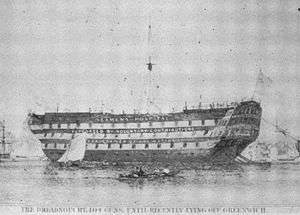Seamen's Hospital Society
Coordinates: 51°28′54″N 0°0′31″W / 51.48167°N 0.00861°W
The Seafarers Hospital Society is a UK charity established in 1821 with the purpose of helping people currently or previously employed in the Merchant Navy or fishing fleets, and their dependants. The Dreadnought Seamen's Hospital continues to the present day under the NHS as the 'Dreadnought Unit' at St Thomas's Hospital and the dedicated Hospital for Tropical Diseases, part of the University College Hospitals London NHS Trust.
The society currently fund the Seafarers' Advice & Information Line, a national advice service operated by the Greenwich Citizens Advice Bureau (GCAB). In addition they provide funds to nursing and residential care units for seafarers, and help those in need by providing hardship grants.[1]
History

The first meeting of the society's committee of management was on 8 March 1821 and they initially provided the Seaman's Infirmary hospital ship using the ex-naval HMS Grampus at Deptford in October 1821.[2] It relocated twice to other ex-naval ships; 1831 to 1857 HMS Dreadnought and then 1857 to 1870 HMS Caledonia (renamed Dreadnought). Following the closure of the Royal Naval Hospital at the site of the Royal Greenwich Hospital in 1869, the society was granted the lease in 1870 and on transferring became known as the Dreadnought Seamen's Hospital, after its last floating home. Thus the Greenwich Hospital switched from the care of ex-members of the Royal Navy to those of the Merchant Navy. Meanwhile, the Dreadnought remained in use as isolation accommodation until 1872.[2]

The Albert Dock Seamen's Hospital was opened in 1890 as a branch of the Dreadnought Seamen's Hospital, Greenwich. The London School of Tropical Medicine was established here in October 1899, by Sir Patrick Manson, and remained there until moving to Euston in February 1920.[3]
In 1919 the dedicated Hospital for Tropical Diseases (HTD) was set up by the Seamen's Hospital Society in the Endsleigh Palace Hotel, 25 Gordon Street (near Euston Square in central London). This was evacuated at the start of the Second World War back to the Dreadnought Hospital in Greenwich. The HTD moved temporarily to 23 Devonshire Street in 1947, before being reestablished under the newly formed NHS in 1951 at the site of the St Pancras Hospital in Camden. The HTD moved again in 1998 to new purpose built premises within part of the University College Hospitals London NHS Trust.
Meanwhile, the in-patient Dreadnought Seamen's Hospital continued at Greenwich until its closure in 1986, with special services for seamen and their families then provided by the 'Dreadnought Unit' at St Thomas's Hospital in Lambeth. This originally consisted of two 28-bed 'Dreadnought wards', but nowadays Dreadnought patients are treated according to clinical need and so are placed in the ward most suitable for their medical condition. Since the formation of the NHS, the Dreadnought Hospital/Unit has been funded by central government with money separate from other NHS trust funds.
The former hospital building is now being redeveloped to become a new Students' Union & study space as part of the University of Greenwich.
See also
References
- The Hospital for Tropical Diseases, article on its history
- Greenwich Guide's history of Dreadnought Seamen's Hospital/Library
Footnotes
- ↑ UK Statutory Instrument 1999 No. 73 - "The Charities (Seamen's Hospital Society) Order 1999". An order amending the Seaman's Hospital Society Act 1833, removing impractical or anachronistic measures and extending benefits to seawomen as well as seamen.
- 1 2 National Maritime Museum Research guide A6: Greenwich and the National Maritime Museum, page 5 "Dreadnought Seamen's Hospital"
- ↑ Archives in London and the M25 area (AIM25) Albert Dock Seamen's Hospital